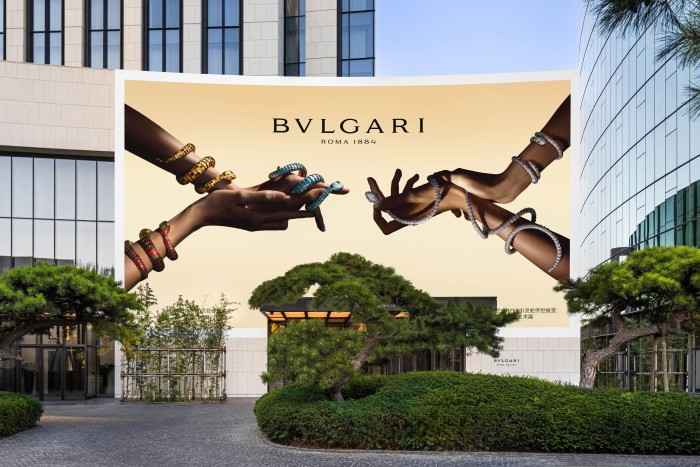Luxury brands’ cultural ties strike a chord with Chinese buyers

Chinese museums are abuzz with exhibitions from European jewellery houses. Over the summer, Bulgari’s travelling exhibition, Serpenti Factory, opened at the Genesis gallery in Beijing, while Shanghai’s Power Station of Art hosted another travelling exhibition, Gabrielle Chanel. Fashion Manifesto, which premiered in London last year.
And, next month, at the Fosun arts centre in Shanghai, Pomellato will unveil its first retrospective of advertising photography, titled Art & Jewellery, while Cartier will juxtapose more than 300 pieces from its archival collection with Chinese art in Cartier: The Power of Magic at the Shanghai Museum.
This flurry of activity illustrates how western brands’ strategy of associating with museums to elevate jewellery to the status of art — and thus increase its desirability — is resonating with Chinese audiences. However, these initiatives go beyond previous efforts by integrating elements of Chinese culture and positioning western brands not just as cultural exporters, but as actively engaging with local creativity.
“When efforts [of integrating Chinese culture] stay on the superficial level, such as a Chinese zodiac sign slapped on an otherwise unchanged product released during Chinese new year, consumer rejection will show up in sales figures,” says Veronique Yang, a senior partner in Shanghai with Boston Consulting Group.


“Nowadays, more and more brands realise that having one or two Chinese elements here or there is cultural stereotyping, not cultural conversations. We see some working closely with Chinese artists and craftsmen as true partners. Events and products born out of such relationships are usually hailed and rewarded by Chinese consumers.”
The look for the Cartier show will be created using cAI, an artificial intelligence model designed by Chinese artist Cai Guo-Qiang. Meanwhile, Pomellato will collaborate with Chinese photographer Chen Man and will showcase a unique high jewellery piece featuring inlay details by her compatriot, master craftsman Guo Weijin.
“China is a relatively new market for the house, and Shanghai is so receptive to art and culture that we felt it was the right spot to stage this exhibition,” says Boris Barboni, Pomellato’s chief marketing officer.
In a similar approach, De Beers Jewellers, which will introduce its new high jewellery collection in China in October, has designed its presentation in collaboration with a group of Chinese artists including Wang Jin, a master restorer at Beijing’s Palace Museum, conductor Ni Fan and ballet dancer Meng Qingyang.
“This aligns with our broader strategy of authentic cultural engagement and our belief in the power of art and culture to create meaningful connections with our clients,” says Céline Assimon, chief executive of De Beers Jewellers.
Sometimes, cultural connections occur serendipitously. Some of Bulgari’s designs, for example, use symbols that feature in Chinese culture. “The Chinese are already familiar with our snake motif as it is prominent in their mythology and zodiac, but also with the shape of the [Divas’ Dream] collection, which for us is inspired by the mosaics in Caracalla’s baths [in Rome] but in China [recalls] the ginkgo leaf,” says Jean-Christophe Babin, Bulgari chief executive.


This overlap also fosters collaborations and reinforces the brand’s authenticity across other cultural activities. Moreover, Bulgari regularly commissions works by Chinese artists for its exhibitions in China. The brand’s Beijing show included seven original artworks, from bamboo sculpture to video animation.
Yang at BCG says Chinese consumers consider cultural relevance to be a key strength for a luxury brand. “Eighty per cent of luxury consumers seek out brands that proactively engage with local Chinese culture,” she says. “They value brands that bring Chinese cultural heritage, such as craftsmanship, deeply into brand storytelling and product creation. Brands that act ‘glocal’ are seen as making a genuine effort at cultural conversations.”
Richemont-owned Van Cleef & Arpels has taken another approach to establish its cultural relevance in China: education, through L’École, School of Jewelry Arts.

Founded in Paris in 2012, L’École offers courses in jewellery history and gemmology, organises exhibitions, and publishes materials related to the art of jewellery.
While Van Cleef & Arpels funds L’École, its curriculum covers the full spectrum of jewellery craftsmanship beyond the house’s collections. Still, industry insiders agree that the brand is the primary beneficiary of this educational venture. Expansion in China has been a priority for L’École, which opened its first overseas campus in Hong Kong in 2019, followed by a second one in Shanghai. As educational ventures by Christie’s and Sotheby’s across Asia show, providing knowledge to consumers who are spending large sums on one-of-a-kind jewels is crucial.
At a time when global luxury sales are slowing — LVMH, Richemont and Kering have all reported dips in sales in 2024 — such initiatives could drive demand. “The key to long-term success lies in a brand’s ability to generate desirability,” says Weiwei Xing, Hong Kong-based partner at consultancy Bain & Company.
“These cultural activities build long-term brand equity, which is a different measure of success compared to short-term sales, which may fluctuate.”
Yang, however, notes that while western brands have become highly skilled at engaging with Chinese consumers, there is a growing need to include deeper elements of Chinese culture beyond the country’s borders. She mentions Loewe’s Crafted World exhibition, which has toured to Shanghai, as best practice.
“With 40 per cent of Chinese luxury consumption happening overseas and 20 per cent of shoppers coming from globally connected new wealth, it’s clear that brands can’t go wrong by enriching their cultural offerings to cater to these increasingly discerning consumers,” Yang says.
#Luxury #brands #cultural #ties #strike #chord #Chinese #buyers






